
Bidens frondosa is a North American species of flowering plant in the aster family, Asteraceae. It is widespread across much of Canada, the United States, and Mexico It is known in many other parts of the world as an introduced species, including Europe, Asia, Morocco, and New Zealand. Its many common names include devil's beggarticks, devil's-pitchfork, devil's bootjack, sticktights, bur marigold, pitchfork weed, tickseed sunflower, leafy beggarticks, and common beggar-ticks.

Hypochaeris glabra is a species of flowering plant in the tribe Cichorieae within the family Asteraceae known by the common name smooth cat's ear. It is native to Europe, North Africa, and the Middle East but it can be found on other continents where it is an introduced species and a widespread weed. It has become widespread in Africa, southern and southeastern Asia, Australia, and parts of the Americas.

Sigesbeckia is a genus of annual plants in the family Asteraceae. St. Paul's wort is a common name for some of the species. Sigesbeckia is widely distributed and has been traditionally used for the management of chronic diseases, including arthritis.
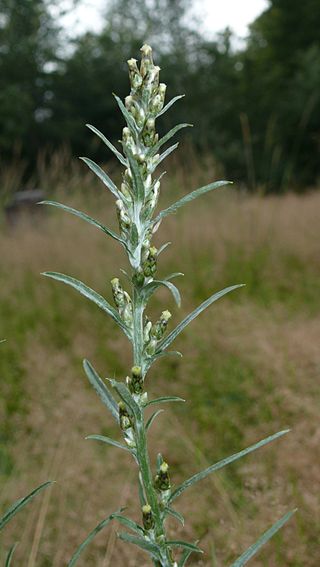
Omalotheca sylvatica, synonyms including Gnaphalium sylvaticum, is a species of plant in the family Asteraceae. It is commonly known as heath cudweed, wood cudweed, golden motherwort, chafeweed, owl's crown, and woodland arctic cudweed. It is widespread across the temperate Northern Hemisphere, throughout North America and Eurasia. The species was first formally described by Carl Linnaeus in 1753 as Gnaphalium sylvaticum.

Senna occidentalis, commonly known as coffee senna, styptic weed, or septicweed, is a species of flowering plant in the family Fabaceae and is native to the southern United States of America, Mexico and South America. It is a shrub with pinnate leaves, with three to seven pairs of broadly elliptic to egg-shaped leaflets, and yellow flowers arranged in groups of two to four, with six fertile stamens in each flower. It is an aggressive, pantropical weed.

Olearia floribunda, commonly known as heath daisy-bush, is a species of flowering plant in the family Asteraceae and is endemic to south-eastern Australia. It is an upright, spreading shrub with egg-shaped leaves and white and yellow or mauve, daisy-like inflorescences.
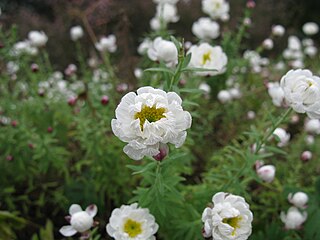
Rhodanthe anthemoides, commonly known as chamomile sunray, is a flowering plant in the family Asteraceae. It is a small, perennial shrub with greyish-green leaves, white papery flowers, yellow centre and is endemic to Australia.
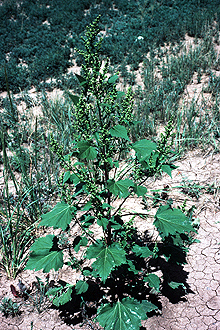
Cyclachaena xanthiifolia, known as giant sumpweed, or rag sumpweed is a North American plant species in the sunflower family, Asteraceae. It is the only species in the genus Cyclachaena. Giant sumpweed is believed to be native to the Great Plains but is now found across much of southern Canada and the contiguous United States, though rarely in the Southeast.
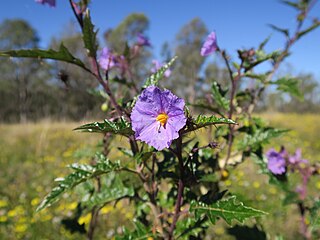
Solanum cinereum, commonly known as Narrawa burr, is a species of flowering plant in the family Solanaceae. It has dark green, spiny leaves and purple flowers and grows in open woodland in south eastern Australia.
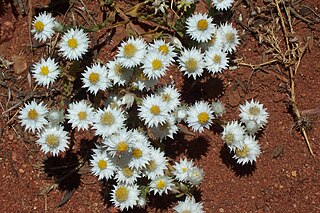
Rhodanthe floribunda, commonly known as common white sunray, is a flowering, herbaceous plant in the family Asteraceae. It is a small, upright or decumbent plant with white flowers, yellow florets and is endemic to Australia.

Calotis lappulacea, commonly known as the yellow burr-daisy, is a flowering plant in the family Asteraceae found in many parts of mainland Australia. It is a small, perennial herb with yellow globular flower-heads.

Craspedia aurantia, is a flowering plant in the family Asteraceae and grows in New South Wales and Victoria. It has light green leaves and heads of yellow to reddish-brown flowers on a single flowering stem.
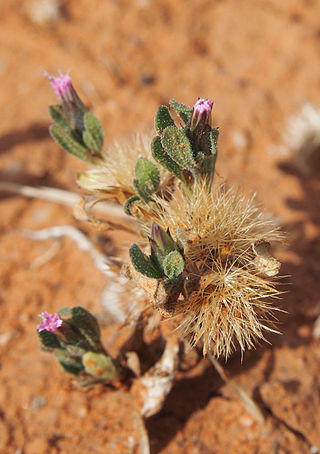
Streptoglossa adscendens, commonly known as desert daisy, is a species of flowering plant in the family Asteraceae and grows in all mainland states of Australia with the exception of Victoria. It is a ground cover, upright or ascending perennial or annual herb with purple or pink flowers.
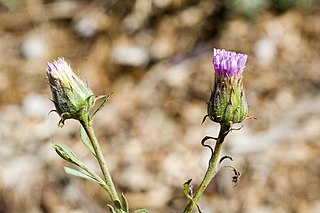
Streptoglossa liatroides is a species of flowering plant in the family Asteraceae. It is a low, spreading or upright perennial herb with pink or red to purple flowers. It grows in South Australia, New South Wales, Western Australia and the Northern Territory.

Streptoglossa odora is a species of flowering plant in the family Asteraceae. It is a spreading, perennial herb with pink or bluish-purple flowers. It grows in Queensland, Western Australia and the Northern Territory.
Streptoglossa tenuiflora is a species of flowering plant in the family Asteraceae. It is an upright perennial or annual herb with pink to purple flowers. It is endemic to Western Australia.
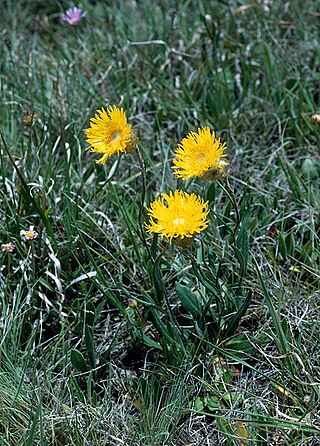
Podolepis decipiens, commonly known as deceiving copperwire-daisy, is a flowering plant in the family Asteraceae and grows in Victoria, Tasmania and New South Wales. It is an upright, perennial herb with yellow daisy-like flowers on a single stem rising from a sparse rosette.
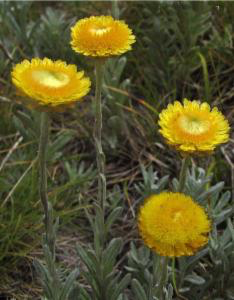
Coronidium monticola, commonly known as the mountain coronidium, is a flowering plant in the family Asteraceae and grows in open forests in eastern Australia. It has woolly, grey-green leaves and mostly yellow flowers.

Calocephalus lacteus, commonly known as lemon beauty-heads, is a species of flowering plant in the family Asteraceae. It has yellow cylindrical shaped flowers and grey stems and grows in the eastern states of Australia

Comesperma retusum, commonly known as milkwort, is a slender herb in the family Polygalaceae. It is an upright shrub with purple or mauve-pink pea-like flowers and grows in eastern Australia.





















